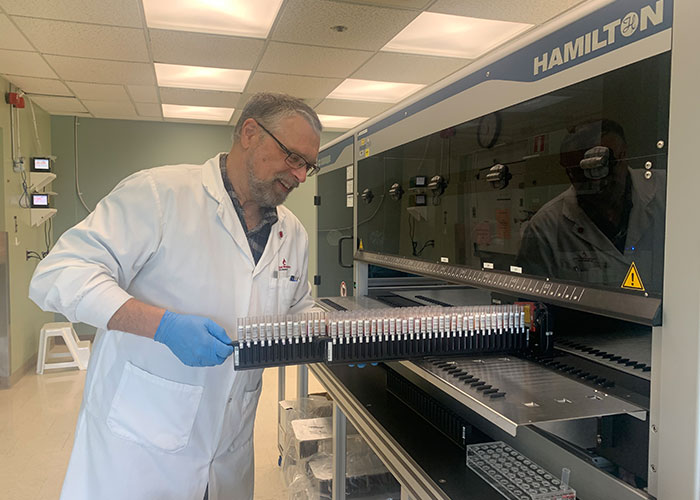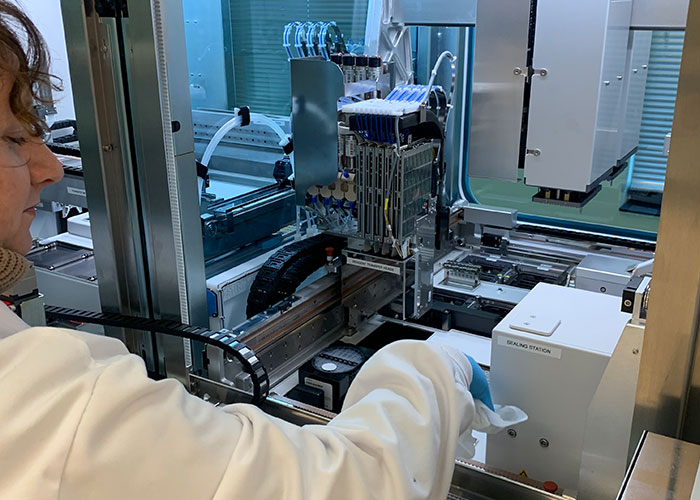New lab leverages Canadian Blood Services research and development expertise with a focus on emerging blood safety initiatives
Friday, May 09, 2025 Abby Wolfe
As Canada’s Biological Lifeline, Canadian Blood Services is entrusted with the vital responsibility of providing safe, reliable access to high-quality products and services essential for individuals across the country.
Our network of dedicated researchers and laboratory staff is integral to our ability to fulfil that responsibility, and the announcement of a new Surveillance & Discovery Laboratory is another example of this ongoing commitment to safety and continuous improvement. This lab will enhance capacity to identify and mitigate threats to the blood supply and strengthen public health preparedness for years to come.
What kinds of threats can the Surveillance & Discovery Lab help the blood system anticipate and adapt to?
At Canadian Blood Services, ‘surveillance’ refers to the ongoing work undertaken to prevent transmissible blood-borne infections by testing blood and monitoring for transmissible disease markers, investigating possible transfusion transmitted infections in blood recipients, and scanning for any new pathogens that may pose a risk to the blood supply.
-
Read Canadian Blood Services’ annual Surveillance Report for more about infectious disease surveillance: Surveillance report | Professional Education
By bringing together the expertise of a dedicated team of laboratory staff and researchers in a space designed to be flexible and scalable, this lab will boost in-house capacity for surveillance by creating and developing new tests that can help protect the blood system.
The new tests of interest, including nucleic acid tests (NAT), will be important as the habitats and range of biting insects like mosquitoes and ticks that may carry transfusion-transmitted infectious diseases change due to global travel and climate factors.

What is a NAT test and when is it used?
Nucleic acids make up DNA and RNA and carry genetic information. Nucleic acid tests, which work by amplifying genetic material, can be used to detect pathogens like viruses and bacteria with high sensitivity. This makes them a powerful tool for use in blood screening to detect potentially transfusion-transmissible infectious agents.
-
Read more about screening tests performed on blood donations at Canadian Blood Services in our Clinical Guide to Transfusion on the professional education website, Profedu.ca: Chapter 6: Donor selection, donor testing and pathogen reduction
A key asset for the future, building on existing expertise
While the laboratory will serve as a research and development hub for new and innovative tests not available elsewhere on the market, it will also be able to validate the performance of existing tests for other transmissible infections that may be implemented into our donor testing operations in the future. This will make the Surveillance & Discovery Lab a key asset in rapidly responding to both potential future pandemics and the spread of emerging or unknown pathogens.

Currently, the laboratory is set to begin the second year of its multi-year tickborne infections surveillance program. This year’s focus will include testing for Babesia, Anaplasma, Powassan virus, and other emerging pathogens as they are identified.
Much prior work has set the stage for this, including important seroprevalence work undertaken at Canadian Blood Services during the SARS-CoV-2 pandemic that tested over a million blood samples between 2020 – 2024.
-
Learn more about this work in our 2023 research impact case study: Understanding immunity in Canada: COVID-19 seroprevalence studies
Over four years, that work provided invaluable insights to public health efforts and significantly increased understanding of donor health trends, underscoring the critical role of Canadian Blood Services’ infrastructure in advancing national health priorities during times of crisis.

Canadian Blood Services – Driving world-class innovation
Through discovery, development and applied research, Canadian Blood Services drives world-class innovation in blood transfusion, cellular therapy and transplantation—bringing clarity and insight to an increasingly complex healthcare future. Our dedicated research team and extended network of partners engage in exploratory and applied research to create new knowledge, inform and enhance best practices, contribute to the development of new services and technologies, and build capacity through training and collaboration. Find out more about our research impact.
The opinions reflected in this post are those of the author and do not necessarily reflect the opinions of Canadian Blood Services nor do they reflect the views of Health Canada or any other funding agency.
Related blog posts
Dr. Sheila O’Brien, Canadian Blood Services’ associate director of epidemiology and surveillance, recently joined Public Health Ontario’s (PHO) webinar series to share ongoing efforts to collect and analyze data on the rates of SARS-CoV-2 (COVID) infection in the blood donor population. This blog summarizes presentation highlights and provides an update on Canadian Blood Services’ contributions to the COVID-19 Immunity Task Force (CITF) seroprevalence research.
Dr. Sheila O’Brien knows the answer. She is the associate director, epidemiology and surveillance, working at Canadian Blood Services head office in Ottawa. Understanding and minimizing the infectious risks associated with blood transfusion is what she does each and every day.
In this blog, Dr. Sandra Ramirez-Arcos and members of Canadian Blood Services microbiology lab look back on 20 years of successful studies and pioneering work focused on advancing knowledge and providing evidence to improve the safety of blood components for transfusion recipients.


